Do you have a question about the Roland TrueVIS SG-300 and is the answer not in the manual?
Identifies and explains the various physical components of the printer unit.
Details the meaning of safety warning labels affixed to the machine.
Provides an overview of the printer's menu structure and navigation.
Covers essential guidelines for safe and proper operation of the printer unit.
Explains how to turn the printer on and off, and related precautions.
Details the types of media supported and conditions for usable media.
Outlines the fundamental steps for loading media and performing basic printing.
Covers essential settings and tips for achieving quality cutting.
Explains the process and troubleshooting for printing with crop marks.
Provides instructions for replacing ink and cleaning liquid pouches.
Covers additional basic tasks like loading sheet media and managing output.
Details routine cleaning procedures for the printer unit.
Provides advanced cleaning methods when normal cleaning fails.
Describes periodic manual cleaning procedures for optimal performance.
Offers solutions for persistent dot drop-out and uneven color issues.
Guides users through replacing consumable parts like wipers and blades.
Explains how to save and load custom settings for media and print jobs.
Details how to configure print heater and dryer temperatures for optimal drying.
Covers functions to correct print misalignment and feed issues.
Guides on adjusting settings for various media types and conditions.
Provides advanced options for fine-tuning cutting conditions and accuracy.
Information on the optional media take-up system.
Explains how to operate the printer using the Mobile Panel application.
Covers miscellaneous functions like test printing and media flange usage.
Manages output operations, including system reports and ink status.
Covers printer settings like language, units, and Bluetooth communication.
Provides procedures for preparing the machine for relocation and reinstallation.
Addresses issues where printing or cutting quality is compromised.
Details causes and solutions for media becoming soiled during printing.
Provides troubleshooting steps for inconsistent or uneven color output.
Offers solutions for problems related to cutting misalignment or skew.
Guides users on how to resolve media jam issues.
Addresses issues related to smooth media feeding and handling.
Provides emergency steps if the print heads stop moving.
Covers various other operational problems and their solutions.
Explains common messages displayed and required user actions.
Details error messages and the steps to remedy them.
Specifies the maximum printable and cuttable areas of the machine.
Provides information on blade types, force, offset, and service life.
Indicates the positions of important identification labels on the unit.
Lists the technical specifications of the printer models.
Identifies and explains the various physical components of the printer unit.
Details the meaning of safety warning labels affixed to the machine.
Provides an overview of the printer's menu structure and navigation.
Covers essential guidelines for safe and proper operation of the printer unit.
Explains how to turn the printer on and off, and related precautions.
Details the types of media supported and conditions for usable media.
Outlines the fundamental steps for loading media and performing basic printing.
Covers essential settings and tips for achieving quality cutting.
Explains the process and troubleshooting for printing with crop marks.
Provides instructions for replacing ink and cleaning liquid pouches.
Covers additional basic tasks like loading sheet media and managing output.
Details routine cleaning procedures for the printer unit.
Provides advanced cleaning methods when normal cleaning fails.
Describes periodic manual cleaning procedures for optimal performance.
Offers solutions for persistent dot drop-out and uneven color issues.
Guides users through replacing consumable parts like wipers and blades.
Explains how to save and load custom settings for media and print jobs.
Details how to configure print heater and dryer temperatures for optimal drying.
Covers functions to correct print misalignment and feed issues.
Guides on adjusting settings for various media types and conditions.
Provides advanced options for fine-tuning cutting conditions and accuracy.
Information on the optional media take-up system.
Explains how to operate the printer using the Mobile Panel application.
Covers miscellaneous functions like test printing and media flange usage.
Manages output operations, including system reports and ink status.
Covers printer settings like language, units, and Bluetooth communication.
Provides procedures for preparing the machine for relocation and reinstallation.
Addresses issues where printing or cutting quality is compromised.
Details causes and solutions for media becoming soiled during printing.
Provides troubleshooting steps for inconsistent or uneven color output.
Offers solutions for problems related to cutting misalignment or skew.
Guides users on how to resolve media jam issues.
Addresses issues related to smooth media feeding and handling.
Provides emergency steps if the print heads stop moving.
Covers various other operational problems and their solutions.
Explains common messages displayed and required user actions.
Details error messages and the steps to remedy them.
Specifies the maximum printable and cuttable areas of the machine.
Provides information on blade types, force, offset, and service life.
Indicates the positions of important identification labels on the unit.
Lists the technical specifications of the printer models.
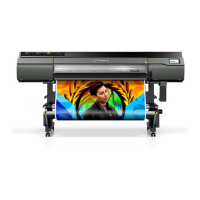
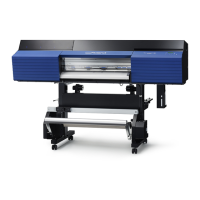
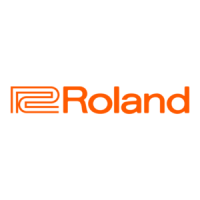



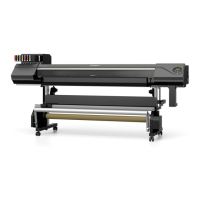
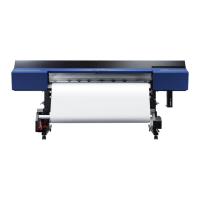

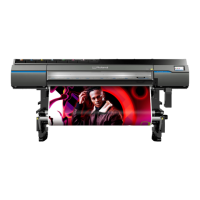

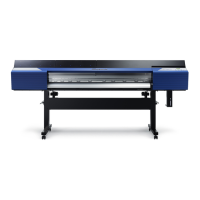
